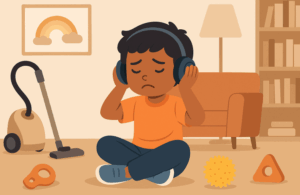🧩 Managing Sensory Issues in Autism: A Practical Guide for Parents
 Children with Autism Spectrum Disorder (ASD) often experience the world in a way that’s very different from others—louder, brighter, rougher, or more overwhelming. This is due to sensory processing differences, which can lead to meltdowns, anxiety, or social withdrawal.
Children with Autism Spectrum Disorder (ASD) often experience the world in a way that’s very different from others—louder, brighter, rougher, or more overwhelming. This is due to sensory processing differences, which can lead to meltdowns, anxiety, or social withdrawal.
Understanding and supporting sensory needs is key to improving behavior, learning, and emotional well-being in autistic children.
🔍 What Are Sensory Processing Issues?
Sensory issues in autism occur when the brain has difficulty filtering, organizing, or responding appropriately to information from the senses.
This can include:
-
Over-responsiveness (hypersensitivity): Easily overwhelmed by sounds, textures, lights, smells, or movement
-
Under-responsiveness (hyposensitivity): May seek out intense sensations or appear unaware of pain or danger
-
Sensory-seeking behaviors: Craving spinning, jumping, touching, chewing, or smelling objects
These can affect any of the 8 sensory systems:
| Sense | Example of Difficulty |
|---|---|
| Touch (tactile) | Refuses certain clothes, reacts to tags, avoids hugs |
| Sound (auditory) | Covers ears during noise, fears vacuum or alarms |
| Sight (visual) | Avoids bright lights, distracted by flickering fans |
| Smell (olfactory) | Strong reaction to perfumes or food smells |
| Taste (gustatory) | Very picky eater, prefers bland or spicy foods |
| Movement (vestibular) | Hates swings or craves spinning |
| Body awareness (proprioception) | Clumsy, presses hard when writing |
| Internal body sense (interoception) | Poor awareness of hunger, pain, or toilet needs |
🛠️ How to Help: Home-Based Strategies
1. 🧘♀️ Create a Sensory-Friendly Environment
-
Use noise-cancelling headphones for loud places
-
Choose soft lighting or natural light
-
Offer calm corners with weighted blankets or beanbags
-
Avoid strong perfumes, incense, or cooking odors when possible
2. 🎨 Observe and Build a Sensory Profile
Each child is different. Track:
-
What triggers them? (e.g., brushing hair, loud birthday parties)
-
What calms them? (e.g., swinging, chewing, water play)
Keep a sensory diary to guide routines and therapies.
3. 🧩 Use Sensory Diets
A sensory diet is a personalized plan of activities that help regulate the child throughout the day.
Examples:
-
Trampoline jumping for 5 minutes before school
-
Chewy tubes or crunchy snacks during study time
-
Deep pressure hugs or massage before bed
-
Visual calm-down jar during meltdowns
Work with an occupational therapist (OT) to create one.
4. 👕 Modify Clothing and Daily Routines
-
Use tagless clothes, soft fabrics, seamless socks
-
Let the child choose clothes they’re comfortable in
-
Use firm pressure during bathing or brushing to reduce light touch irritation
-
Introduce new routines gradually with visual schedules
5. 🎧 Prepare for Public Places
-
Use visual social stories to explain what to expect
-
Carry a “sensory toolkit” with:
-
Headphones
-
Fidget toys
-
Sunglasses
-
Snacks
-
Weighted lap pad
-
6. 🧠 Teach Emotional Awareness
Children with sensory issues often can’t express discomfort verbally.
-
Use feelings charts or emoji cards
-
Help label feelings: “Are you feeling itchy? Too loud? Too bright?”
-
Encourage self-advocacy: “Can I wear my headphones?”
🏫 School and Therapy Support
-
Request an OT assessment through school or privately
-
Ask for sensory breaks or a calm-down zone
-
Share your child’s sensory profile with teachers
-
Use visual supports (first-then cards, schedules)
🔔 Example: “First desk work, then trampoline.”
🚩 When to Seek Professional Help
Consult an occupational therapist or child psychiatrist if:
-
Sensory issues cause meltdowns, aggression, or avoidance
-
Child refuses self-care (bathing, brushing, dressing)
-
School performance is affected
-
You feel overwhelmed trying to manage it alone
💡 Final Word
Sensory differences in autism are real and valid. With understanding, accommodation, and structured sensory input, you can transform distress into calm, focus, and confidence.
Every child deserves to feel safe in their own body and environment—and parents deserve tools to help them get there.
Dr. Srinivas Rajkumar T, MBBS, MD (Psychiatry)
Consultant Psychiatrist
Apollo Clinics Velachery & Tambaram
🔵 Autism, Sensory & Behavioral Health Specialist
🌐 Visit: www.srinivasaiims.com
📞 Available for online & offline consultations